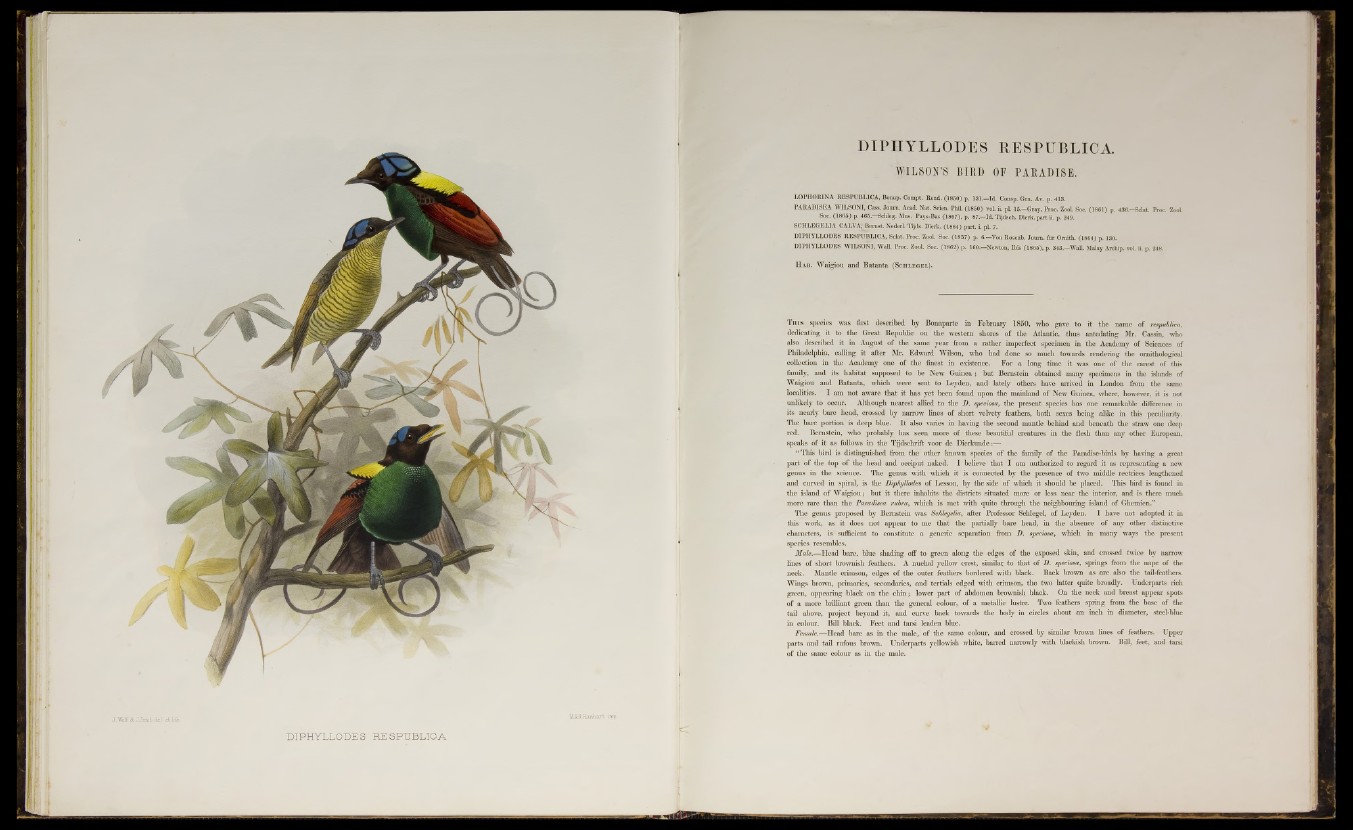
D IPH Y L LO D E S R E S PT JB L ICA
.WILSON'S BIRD OF PARADISE.
LOPHORINA RESPUBLICA, Bonap. Compt. Rend. (1850) p. 131 Id. Consp. Gen. Av. p. 413.
PARADISEA WILSONI, Cass. Joum. Acad. Nat. Seien. Phil. (1850) vol. ii. pi. 15.—Gray, Proc. Zool. Soc. (1861) p. 436.—Sclat. Proc. Zool.
Soc. (1 8 6 5 ) p. 465.—Sehîeg. Mus. Pays-Bas (1867), p. 8 7—Id. Tijdsch. Dierk.part i l p. 249.
SCHLEGELIA CALVAj1 B emst. Nederl. Tijds. Dierk. (1864) part. i. pi. 7.
DIPHYLLODES RESPUBLICA, Sclat. Proc. ZooL' Soc. (1857) p. 6.—Von Rosenb. Journ. fiilr Ornith. (1864) p. 130.
DIPHYLLODES WILSONI, Wall. Proc. Zool. Soc. (1862) p. 160.—Newton, Ibis (1 865), p. 343.—W a ll Malay Archip. vol. ii. p. 248.
H a b . Waigiou and Batanta (Sc h l eg e e ).
T h i s species was first described by Bonaparte in February 1850, who gave to it the name of respublica,
dedicating it to the Great Republic on the western shores o f the Atlantic, thus antedating Mr. Cassin, who
also described it in August o f the same year from a rather imperfect specimen in the Academy of Sciences of
Philadelphia, calling it after Mr. Edward Wilson, who had done so much towards rendering the ornithological
collection in the Academy one of the finest in existence. For a long time it was one of the rarest of this
family, and its habitat supposed to be New Guinea; but Bernstein obtained many specimens in the islands of
Waigiou and Batanta, which were sent to Leyden, and lately others have arrived in London from the same
localities. I am not aware that it has yet been found upon the mainland of New Guinea, where, however, it is not
unlikely to occur. Although nearest allied to the D. speciosa, the present species has one remarkable difference in
its nearly bare head, crossed by narrow lines of short velvety feathers, both sexes being’ alike in this peculiarity.
The bare portion is deep blue. It also varies in having the second mantle behind and beneath the straw one deep
red. Bernstein, who probably has seen more of these beautiful creatures in the flesh than any other European,
speaks of it as follows in the Tijdschrift voor de Dierkunde:—
“ This bird is distinguished from the other known species of the family o f the Paradise-birds by having a great
part of the top o f the head and occiput naked. I believe that I am authorized to regard it as representing a new
genus in the science. The genus with which it is connected by the presence of two middle rectrices lengthened
and curved in spiral, is the Diphyllodes of Lesson, by the side of which it should be placed. This bird is found in
the island of Waigiou; but it there inhabits the districts situated more or less near the interior, and is there much
more rare than the Paradisea rubra, which is met with quite through the neighbouring island of Ghemien.”
The genus proposed by Bernstein was Schlegelia, after Professor Schlegel, of Leyden. I have not adopted it in
this work, as it does not appear to me that the partially bare head, in the absence of any other distinctive
characters, is sufficient to constitute a generic separation from D. speciosa, which hr many ways the present
species resembles.
Male.—Head bare, blue shading off to green along the edges of the exposed skin, and crossed twice by narrow
lines o f short brownish feathers. A nuchal yellow crest, similar to that of JD. speciosa, springs from the nape of the
neck. Mantle crimson, edges of the outer feathers bordered with black. Back brown as are also the tail-feathers.
Wings brown, primaries, secondaries, and tertials edged with crimson, the two latter quite broadly. Underparts rich
green, appearing black on the chin; lower part of abdomen brownish black. On the neck and breast appear spots
of a more brilliant green than the general colour, of a metallic lustre. Two feathers spring from the base of the
tail above, project beyond it,- and curve back towards the body in circles about an inch in diameter, steel-blue
in colour. Bill black. Feet and tarsi leaden blue.
Female.—Head bare as in the male, o f the same colour, and crossed by similar brown lines of feathers. Upper
parts and tail rufous brown. Underparts yellowish white, barred narrowly with blackish brown. Bill, feet, and tarsi
of the same colour as in the male.